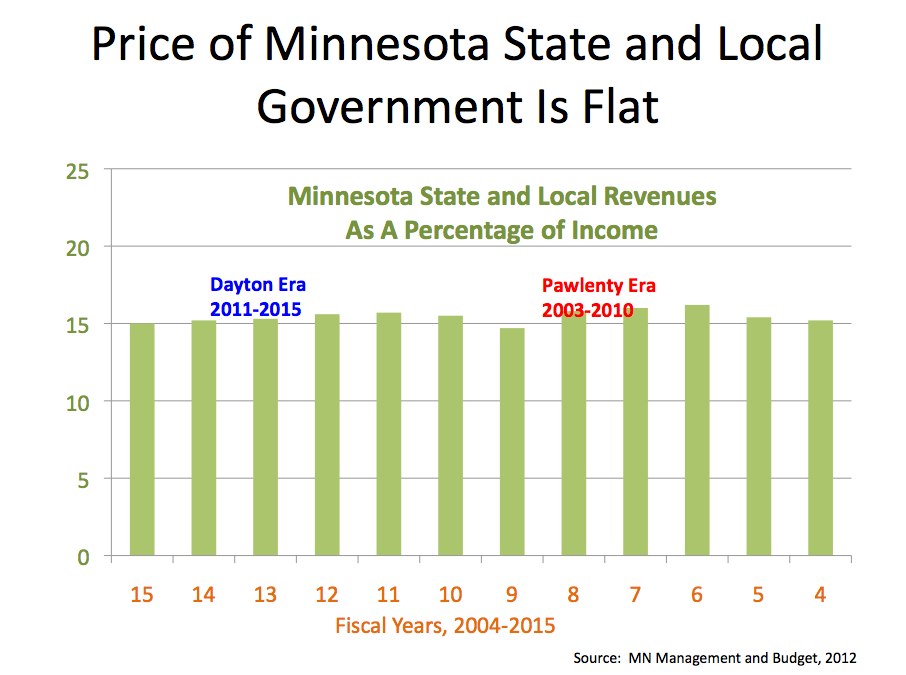In this year’s battle for control of the Minnesota State Capitol, Republicans and DFLers alike hyperventilate over government spending. DFLers maintain Minnesota has drastically cut state and local government. Republicans claim that state and local government spending is skyrocketing out-of-control.
Candidates on both sides exaggerate. Over the last decade, Minnesota has had divided government – with Governor Dayton checked by a GOP-controlled Legislature and Governor Pawlenty checked by a DFL-controlled chamber of the Legislature. Divided government has produced a remarkably flat price of state and local government for Minnesotans, hovering right around 15% of average annual income.
In other words, for every dollar of personal income, Minnesotans are paying about fifteen cents to pay for services provided by state and local governments, and that hasn’t changed much over the years. Unlike the numbers thrown around on the campaign trail, this metric accounts for changes in personal income, and burden shifts between state and local governments.
But while the price of government is neither “skyrocketing” nor “slashed,” it is proving to be insufficient to build the kind of Minnesota economy we need. At the 15% price of government level we have maintained for the last decade, we are underinvesting in many things that are critically important to Minnesota’s future.
Take higher education. After years of state lawmakers’ squeezing higher education budgets, students at Minnesota’s 4-year public institutions now pay about $1,100 more per year in tuition and fees than the national average. With higher ed costs increasing in Minnesota, more young people will not be able to afford the education they need to compete in the global marketplace, and many of the brightest students will leave the state for a better deal, and not return. In the Information Age, Minnesota needs a highly educated workforce, so we need to retain those young people, and keep their debt load manageable.
By the way, you can’t blame the drop in higher education funding on lack of public support. A recent national survey found that a solid majority would be willing to pay higher taxes if they knew the money would be dedicated to higher education (55% are either “very willing” or “somewhat willing”). The same survey found that an even larger majority of Americans are willing to pay higher taxes if the proceeds were dedicated to pre-K and K-12 education.
Beyond investments in human capital, Minnesota’s investment in physical infrastructure also is falling short. The Minnesota Transportation Alliance reports that under status quo spending levels — Minnesota’s current 15% price of government flatline — Minnesota will have about $30 billion of transportation needs that go unfunded over the next 20 years. With those transportation infrastructure needs unmet, Minnesota will have a less efficient economy, and therefore will be a less desirable place to locate, retain or expand a business.
The public will exists to spend more on transportation as well. A 2010 Hart survey found that 61% of Americans would favor a governor who offered a plan that “provides more choices such as buses, carpools, light rail, van service, and commuter rail.” Two-thirds (64%) said that such choices were a very good or good value.
Again, the campaign rhetoric is wrong. Government spending in Minnesota is not “out-of-control.” It’s flat, and our status quo spending level is proving insufficient to fuel our economy over the long-run. Minnesota needs to be paying a higher price for state and local government than it has over the past decade, and the public looks ready to pay it.
– Loveland
Note: This post was also featured as a “best of the best” in Minnpost’s Blog Cabin feature.

